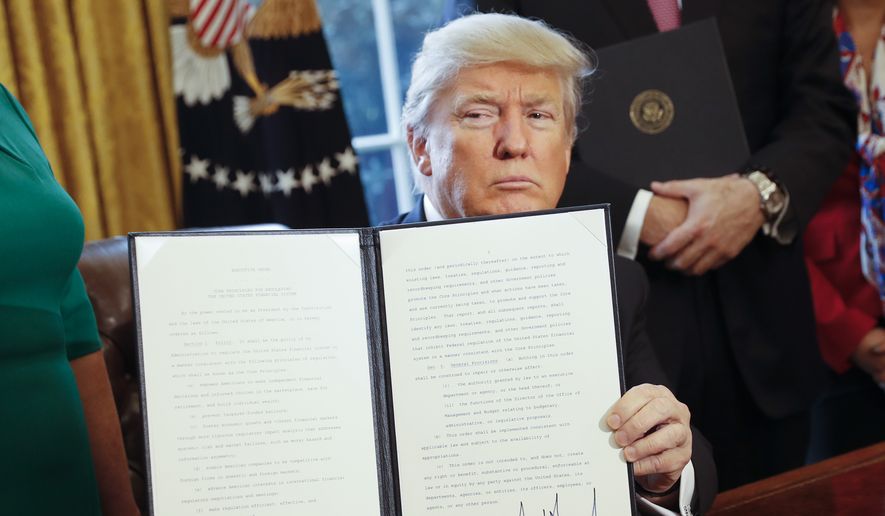OPINION:
Don’t get nervous, Trump voters in Middle America.
You elected Donald Trump president because you wanted to see change — a change that former President Barack Obama never delivered. You may have voted Republican for the first time in 2016, or were motivated to get to the ballot box the first time in a long time on the hope of an economic revival.
And now — a mere three weeks into Mr. Trump’s presidency — you’re starting to think he may not deliver. In an interview with Fox News’ Bill O’Reilly, Mr. Trump said the Obamacare repeal and replace may not come until next year, and tax reform seems to have taken the backseat to Mr. Trump’s border and immigration policies.
The Associated Press on Tuesday did a story detailing Crawford County, Wisconsin, which went red for the first time in 30 years last November.
“In this corner of middle America, in this one, small slice of the nation that sent Trump to Washington, they are watching and they are waiting, their hopes pinned on his promised economic renaissance,” the AP reported. “And if four years from now the change he pledged hasn’t found them here, the people of Crawford County said they might change again to someone else.”
Based on my reporting, all of that is true. But there’s also no reason to fret that Mr. Trump won’t deliver at this point in his presidency.
There’s actually a lot to be praised.
One of the main hindrances to economic growth is excessive government regulations, and this is where Mr. Trump has already taken a sledgehammer. His aim is to cut the regulatory state by 70 percent.
Last week, after meeting with small business owners, Mr. Trump signed an executive order limiting regulation on them. For any new regulation a federal agency enacts, it must eliminate two.
A recent survey on small business regulations by the National Small Business Association found small business owners spent, on average, $12,000 a year on regulations, with 58 percent of the owners saying federal regulations were the most burdensome.
For many small businesses, $12,000 may be the difference between a profitable year and one spent in the red — for those who survive on Main Street, and for those who fold.
The order also will give much power to the Office of Management and Budget director, who will be charged with enforcing that agencies don’t create rules that impose regulatory costs on the economy. New rules with higher costs will have to be offset by lowering costs on existing rules.
On Friday, Mr. Trump signed an executive order directed at rolling back Dodd-Frank financial regulations, which suffocated many small banks with its excessive rules.
The order directs the Treasury Department to initiate a review of the law with other agencies to identify what changes may need to be made.
Congress is also dusting off the Congressional Review Act (CRA) to start to clean off the books regulations made in the Obama administration.
Last week, the House of Representatives voted to undo five Obama-era regulations and sent two to the Senate. According to Susan Dudley, the director of the George Washington University Regulatory Studies Center, 150 or so Obama rules are at risk, including the Environmental Protect Agency’s methane rule and the Labor Department’s overtime pay rule.
Not only does the CRA allow for rules to be thrown away, it also holds that the rule in question may not be issued in “substantially the same form” again, unless Congress proposes a new law. This means agency bureaucrats can’t reinstate a rule that gets shuttered by Congress.
The conservative Heritage Foundation estimated that Mr. Obama’s imposed regulations cost the U.S. economy $108 billion a year. The Competitive Enterprise Institute estimated that in 2015 federal regulations cost $1.9 trillion, about half of the federal budget.
Obamacare was always going to be a sloppy mess to repair, and the GOP should be cautious in replacing it, because as soon as they do, they own it.
Republicans are also having a hard time coalescing their plans and will likely need Mr. Trump’s Department of Health and Human Services Cabinet pick, Rep. Tom Price, to be confirmed before any progress is made on that front.
Tax reform was always thought to come after Obamacare, but some in Congress are bullish about its prospects this year.
Rep. Peter Roskam, Illinois Republican and tax policy chairman for the House Ways and Means Committee, said: “I think a year from now we’re going to be celebrating this tax reform act,” in a speech to the conservative Heritage Foundation Monday.
That would be a welcome prospect, but perhaps, too aggressive in reality.
There’s no doubt some in Middle America may be wobbling in their support for Mr. Trump as they see potential gridlock in Washington stalling his agenda. The markets, which surged after Mr. Trump’s victory, have also petered out in recent weeks on much of the same fears.
But don’t fret too much. It’s still early.
Economist Stephen Moore wrote on Monday that Mr. Trump could create a bull economy if he makes his tax cuts retroactive to Jan. 1, 2017, suspends the Obamacare tax-investment, and demands Congress enact either tax cuts or a 10 percent repatriation tax, in the first 100 days, so that businesses can start investing now.
If there’s one thing that Mr. Trump is, he is a bold disrupter, and many of his Cabinet nominees are also successful businessmen and fellow economic warriors. Once everyone gets into place (including Treasury Secretary Steve Mnuchin and OMB Director Rep. Mick Mulvaney), that’s when you’ll visually start to see the economic change.




Please read our comment policy before commenting.